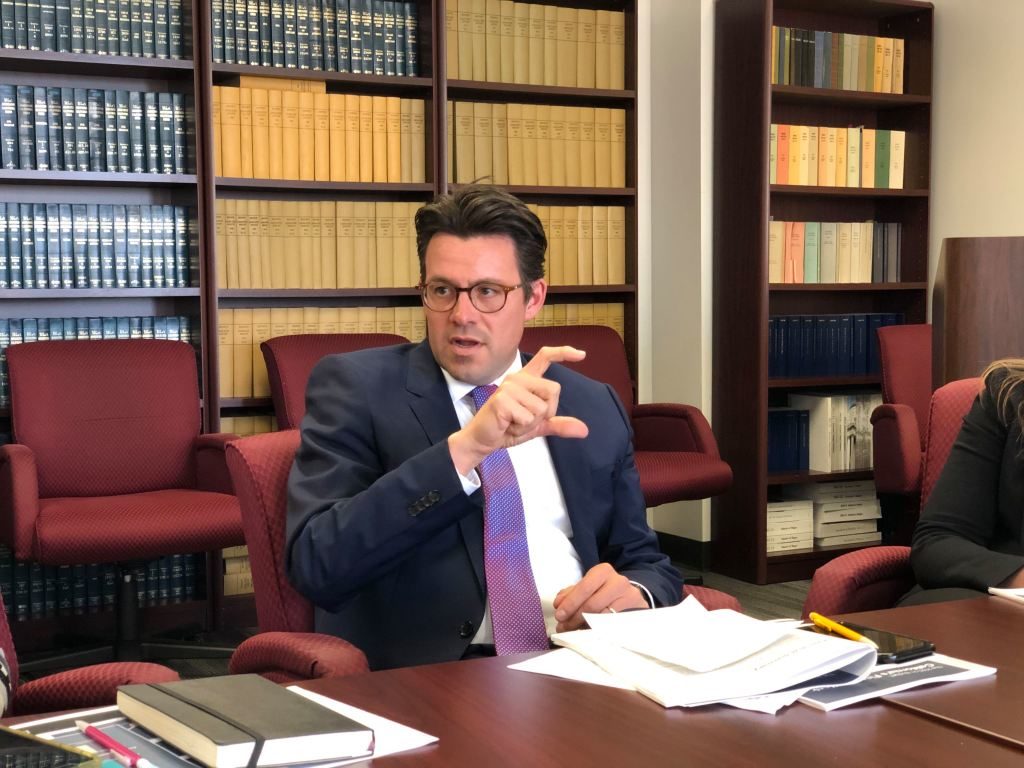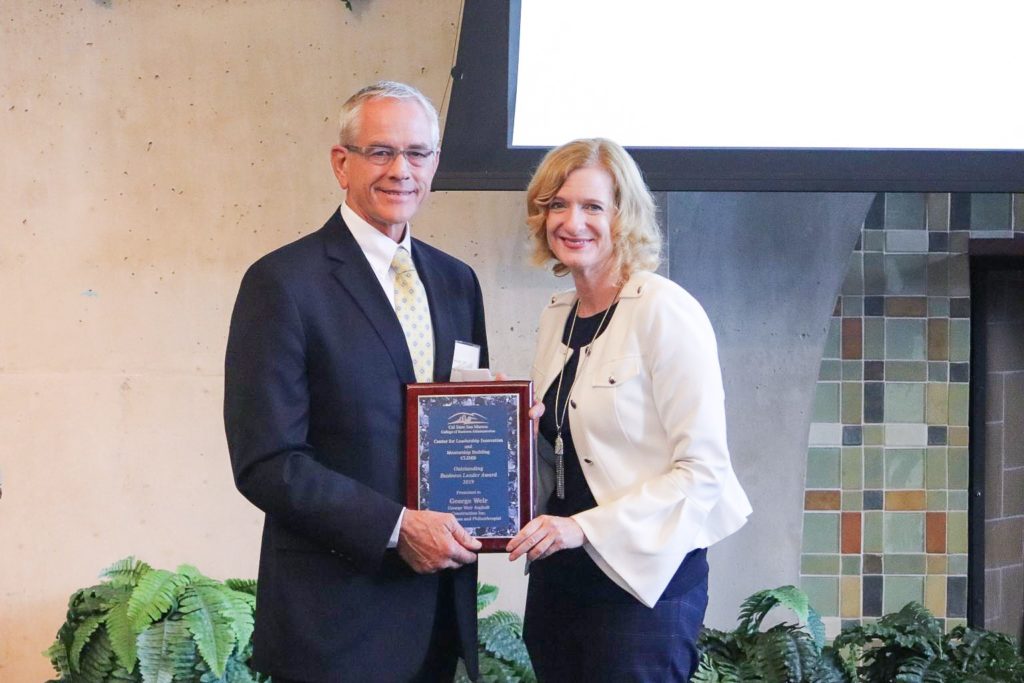Daily Business Report-Nov. 22, 2019
About 35 million people worldwide have died of the immunodeficiency syndrome, AIDS, which is caused by HIV infection. (Courtesy of Scripps Research)
Scripps Research reaches important
milestone in developing effective HIV vaccine
An experimental HIV vaccine developed by scientists at Scripps Research and the nonprofit vaccine research organization IAVI has reached an important milestone by eliciting antibodies that can neutralize a wide variety of HIV strains.
The tests, in rabbits, showed that these “broadly neutralizing” antibodies, or bnAbs, targeted at least two critical sites on the virus. Researchers widely assume that a vaccine must elicit bnAbs to multiple sites on HIV if it is to provide robust protection against this ever-changing virus.
The promising results, which appear in Immunity, suggest that researchers are one step closer to developing an effective HIV vaccine—a major goal of medical science ever since the virus was identified in 1983.
“It’s an initial proof of principle but an important one, and we’re now working to optimize this vaccine design,” says the study’s senior author Richard Wyatt, a professor in the Department of Immunology and Microbiology at Scripps Research.
According to UNAIDS, about 35 million people worldwide have died of the immunodeficiency syndrome, AIDS, which is caused by HIV infection. About 38 million others are now living with HIV infection. Antiviral drugs can keep HIV-infected people alive and reduce their ability to transmit the virus to others, but these drugs do not clear the infection and must be taken indefinitely. Researchers have long recognized that a preventive vaccine, available at a low cost to uninfected people, will be needed to eliminate HIV as a major public health threat.
____________________
Cubic strikes $200 million deal
for remaining stake in Pixia

Cubic has exercised an option in a purchase agreement to acquire the remaining 80 percent stake in Herndon, Va.-based commercial software firm Pixia for approximately $200 million.
Cubic said it expects the all-cash transaction to conclude by February 2020 and will use borrowings under its existing credit facilities to fund the deal.
Pixia offers cloud-based platforms designed to access and manage large amounts of imagery data, wide-area motion imagery and geospatial data for U.S. intelligence agencies and other government customers.
Bradley Feldmann, chairman, president and CEO of Cubic, said Pixia builds up the company’s command, control, intelligence, surveillance and reconnaissance digital platform and battlefield cloud strategy. He added that the combined firm will offer best-in-class platforms to help the intelligence community address big data challenges.
In August, Cubic announced that it acquired a 20 percent stake in Pixia for $50 million in cash to expand the portfolio of its mission solutions business.
Cubic Mission Solutions saw its sales rise 32 percent to $125.5 million during the fourth quarter of fiscal 2019 and posted a 59 percent increase in full-year sales, demonstrating growth from all product lines, specifically secure network products and expeditionary satellite communications.
____________________

State budget grows
Additional $7 billion surplus expected
Dan Morain | CalMatters
Predictions of an economic slowdown aside, California is expected to have an additional $7 billion surplus. Given existing reserves, California could start the 2020-21 fiscal year with $26 billion beyond its expenses, Legislative Analyst Gabriel Petek said Wednesday.
Petek attributed the $7 billion surplus in part to the economic expansion dating to 2009, and to decisions made by voters, former Gov. Jerry Brown and past legislatures:
- Proposition 2 of 2014 requires the state to place a portion of its revenue into a savings account known as the “rainy day fund.”
- Propositions 30 of 2012 and 55 of 2016 raised income taxes.
Brown and legislators used relatively conservative revenue estimates and constrained spending increases.
- Petek: “All of these things contribute to particularly strong fiscal trends over an extended period of time.”
Petek’s analysis warns that “there likely is greater risk in the economic outlook for 2020‑21 than in previous budget cycles,” and said a recession could strike in early 2021.
The budget is a sort of economic indicator. When times are good, California collects more income, sales and corporate tax revenue. Budget deficits occur in recessions.
The L.A. Times: State employment officials estimate that California is responsible for more than 15 percent of the nation’s job growth since 2010.
____________________
SANDAG announces $60,000 in
grants to encourage people to go by bike
The SANDAG iCommute program is offering $3,000 mini-grants for programs or projects that promote biking through outreach and education. Projects will help the San Diego region gear up for the 30th annual SANDAG Bike to Work Day on May 14, 2020. A total of up to $60,000 is up for grabs.
Eligible applicants include local government agencies; community-based and nonprofit organizations; business improvement districts, main street associations, and chambers of commerce; and colleges and universities. Public and private (K-12) schools and San Diego County school districts also are eligible if they partner with a community-based or non-profit organization.
To qualify for a SANDAG GO by BIKE mini-grant, activities must be free, open to the public, and focused on bike education, safety, and promoting biking as an everyday transportation option.
Applications will be accepted now through Jan. 3, 2020, at 5 p.m. Successful applications will be announced by Jan. 31, 2020, and funded activities must take place between March 14 and June 14, 2020. Complete details on eligibility, evaluation and selection criteria, timelines, and application procedures are available on the SANDAG iCommute Bike Month web page.
____________________

App teaches sketching skills to improve
graduation rates in science and engineering
UC San Diego News Center
Engineers at the University of California San Diego have developed a touchscreen app to teach students how to sketch 2D projections and 3D views freehand. This teaches students spatial visualization—the ability to think in 3D.
This skill is important in many STEM fields, from Computer-Aided-Design (CAD) in engineering to using ultrasound for medical procedures.
The Spatial Vis Engineering app is now available in the Apple App Store and Google Play Store for phones and tablets, and can also run on newer Chromebooks.
The app offers exercises that ask students to draw sketches of objects that are rotated in different directions. The sketches are automatically graded. If students make mistakes, they can ask for a hint and try again. The primary target audience is freshman engineering courses to help students become more proficient at CAD, but many others may benefit as well.
____________________

Escondido’s George Weir named 2019
Outstanding Business Leader of the Year
George Weir, an Escondido businessman and philanthropist, has been recognized as the 2019 Outstanding Business Leader of the Year by the Cal State San Marcos Center for Leadership, Innovation and Mentorship Building (CLIMB).
Weir received the award among business community members, faculty and students at CLIMB’s Fall 2019 Leadership Seminar on Nov. 15.
Weir is the founder and owner of George Weir Asphalt Construction, the flagship of his seven Escondido-based companies. His business is not only successful, it’s also sustainable. Weir Asphalt was the first in California to use warm-mix asphalt, which, because it is mixed at a lower temperature, uses less fuel, is less expensive, and reduces greenhouse gases by up to 70 percent.
Weir also was honored by CLIMB for his philanthropic work and dedication to the community. Since 2010, he has repaired hundreds of potholes for free in his native Escondido. He also has stepped in frequently to support the California Center for the Arts, Escondido, and multiple events for nonprofit organizations.
Weir and his wife, Cindy, have three sons.
“We’ve been given so much that we want to give back,” Weir told the San Diego Union-Tribune for a 2011 article. “It’s a pleasure, it’s a privilege, and it’s a lot of doggone fun.”
____________________
General Atomics researcher honored
for career achievement in fusion science

The Fusion Power Associates Board of Directors has selected Dr. Edward (Ted) Strait to receive its Distinguished Career Award for his contributions to fusion science and advancing the performance of fusion plasmaStrait, a General Atomics (GA) physicist since 1982, has led multiple research groups at the DIII-D National Fusion Facility, including the Stability and ITER Physics research groups. His research has covered a broad range of topics related to plasma stability and magnetic measurements. Strait is also a member and past chair of the International Tokamak Physics Activity’s Topical Group on Magnetohydrodynamic Stability.
According to FPA, Strait was honored for “decades of outstanding scientific contributions that have led to advancing the performance of tokamak plasmas, and especially for his leadership in areas leading to the achievement of extremely high beta equilibria and validation of predicted stability limits, and for the design, implementation and interpretation of measurements of fluctuating and equilibrium 3D magnetic fields that have significantly advanced the prospects for fusion power.”
“This award is highly appropriate, given the many years of groundbreaking and prize-winning work by Ted, helping to keep DIII-D at the forefront of fusion energy science,” said GA Energy Group Senior Vice President Jeff Quintenz. “We are fortunate to have so many talented researchers like Ted at DIII-D.”



